Please use the following link to download the June 4, 2022 issue of the syəcəb
Author: Kim Kalliber
Leveling up in the educational journey
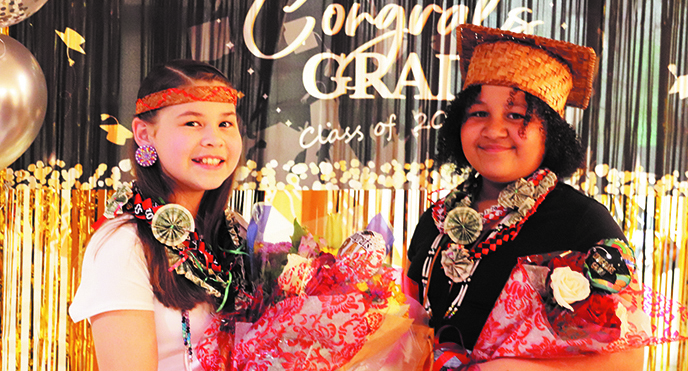
By Kalvin Valdillez, Tulalip News
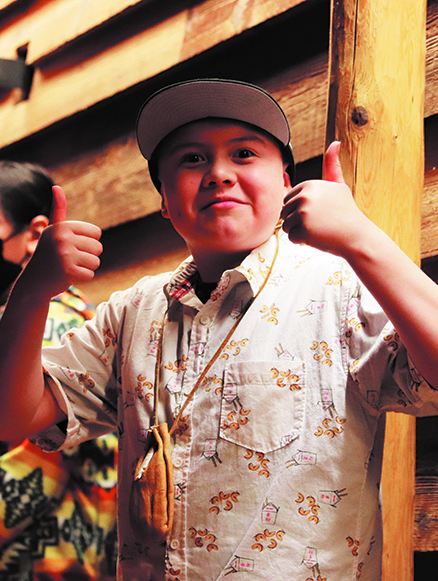
It is that time of year again. Sometimes referred to as cap and gown season, the beginning of summer marks the end of yet another academic year. Young students are often filled with optimism and pride as they close their school year strong before the summertime break, and look forward to a new opportunity come Fall as they begin the next grade in their education career. High school and college graduates are celebrated for their major achievements before they move onto the next challenge and phase of their lives.
There are a few other transition periods that young students go through in the pursuit of diplomas and degrees, including the completion of elementary and junior high school. Big changes lay ahead for this year’s group of 5th and 8th grade students, and the community showed their love and support for the local students who recently leveled-up in their educational journey, moving up to middle and high school respectively.
5th Grade Honoring: Next Stop – Junior High
Nearly 40 young Native American students will be taking the next step in their education journey next Fall as they move on from elementary school to middle school. A handful of students gathered at the Hibulb Cultural Center on the evening of May 25th and the young learners were recognized for all their hard work and academic achievements.
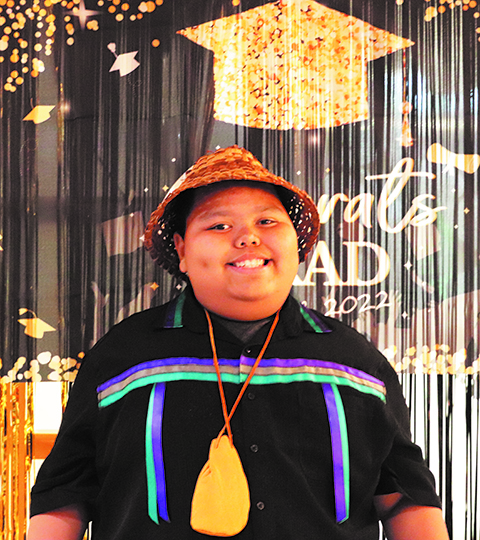
“I graduated from Kellogg Marsh and I am going to Cedar Crest,” said 5th Grade Graduate, Marco Garcia. “Going into middle school, I am most looking forward to art!”
The annual 5th grade honoring was co-coordinated and funded by the Tulalip Education Division and Positive Youth Development team. The honoring united students from over ten different elementary schools throughout the district.
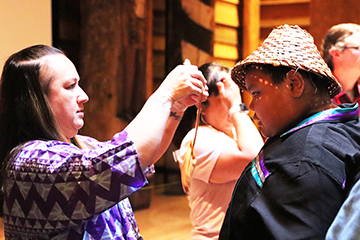
The new middle schoolers formally met the Marysville School District Native liaisons as well as some of their future classmates. The Tulalip Youth Council was in attendance and invited the recent graduates to participate in local events for the youth, and also encouraged the kids to run for the youth council during next year’s elections.
Both Tulalip tribal leaders and MSD officials shared inspiring words with the students about the value of a good education as well as the importance of continuing to learn and practice their cultural teachings. Pixie Owyen was also honored for her work with the Native MSD students over the past 28 years.
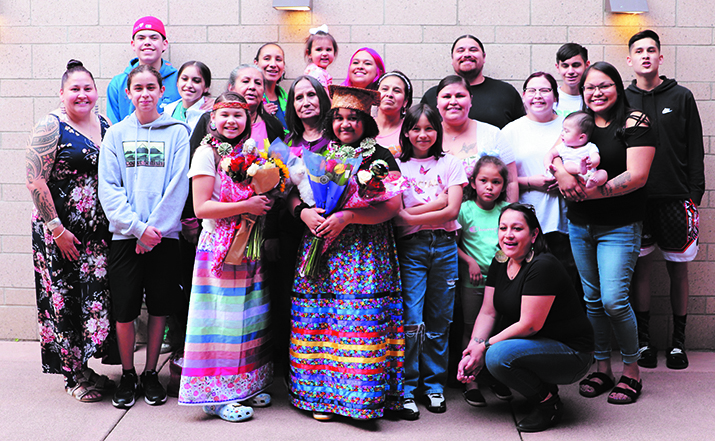
Young Madison Sheldon proudly expressed, “Today was a day of honoring, when 5th graders graduate from elementary school. I’m coming from Liberty elementary. I’m trying to go to 10th street middle school, and I am on the waiting list. I’m looking forward to getting good grades and trying to meet my goals.”
8th Celebration: On to High School
On May 31st, the Tulalip Education Division and the Marysville School District Indian Education department held a special ceremony at the Greg Williams Court gymnasium.
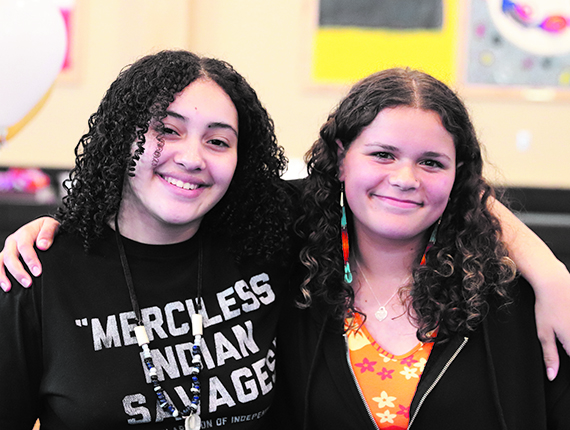
Proud parents, grandparents, aunties and uncles celebrated approximately twenty local youth, consisting of both Tulalip tribal members and other tribal members, who completed their journey in junior high this year.
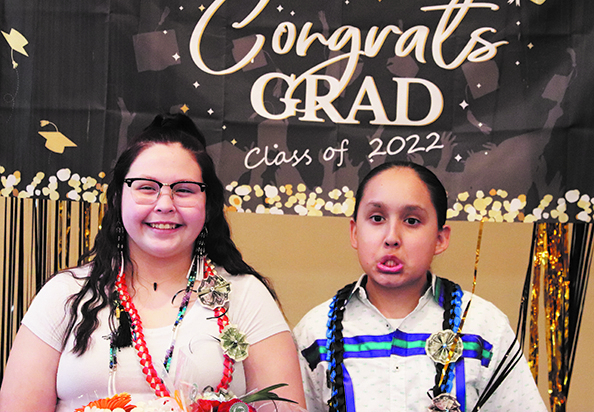
“Today was good, I feel really happy,” stated 8th Grade Graduate, Amaya Hernandez. “I am graduating from Immaculate Conception and Our Lady of Perpetual Help and I am going to Archbishop Murphy High School. I am looking forward to sports the most – volleyball, basketball and softball. And my long-term goal – I want to be a doctor!”
Moving on to high school from middle school is a big step and a number of tribal leaders offered words of encouragement to the students, including Chairwoman Teri Gobin, the MSD Native Liaisons, and Montana State University Hooper RaeQuan Battle. The Marysville-Getchell Native American and Friends club attended the celebration and introduced themselves to the soon-to-be freshmen while inviting them to join the club.
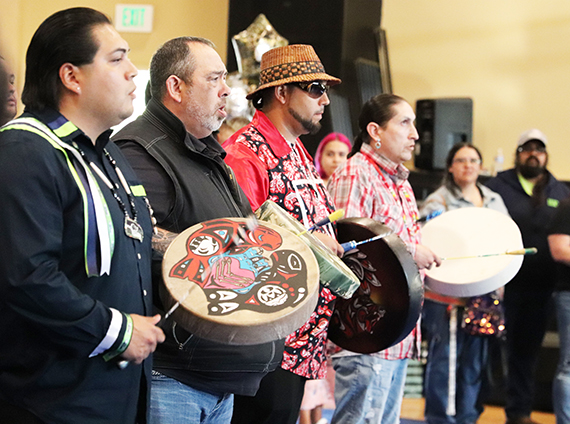
Lushootseed Language Warrior Maria Rios was honored as well for her dedication to revitalizing and preserving the traditional Tulalip language and passing on her teachings to the students of MSD throughout the years.
Following the moving ceremony, the celebration closed with traditional song and dance. The kids were dressed in their regalia. Wearing ribbon shirts and skirts, they took to the floor as everyone gathered in a circle and drumbeats echoed through the gymnasium.
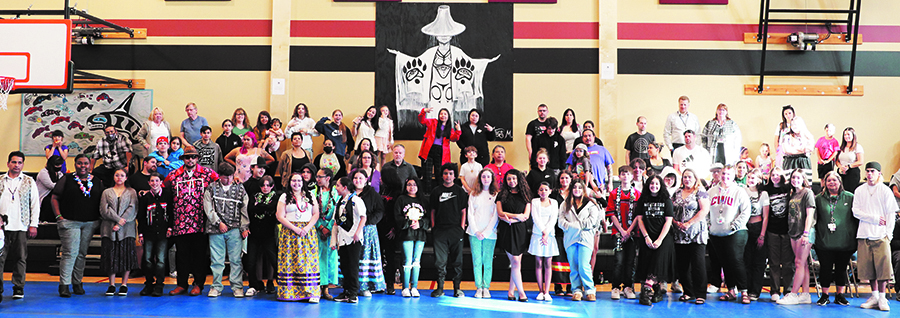
Said young graduate, Raylee Lewis, “We celebrated our years through school tonight by using our cultural teachings. We did the honoring song, the welcoming song. We all got to eat and celebrate with our families and teachers. Connecting with my roots is really important, and I’ve done it my whole life. As I’ve grown older, I realized the significance of it and being with my community, and how it will help me grow and everybody else grow. This makes me feel really happy because I knew a lot of these kids since preschool. I am going to do running start, that’s my biggest goal for high school – and learning Lushootseed!”
Congratulations to all the graduates!
“We remember so we don’t forget”
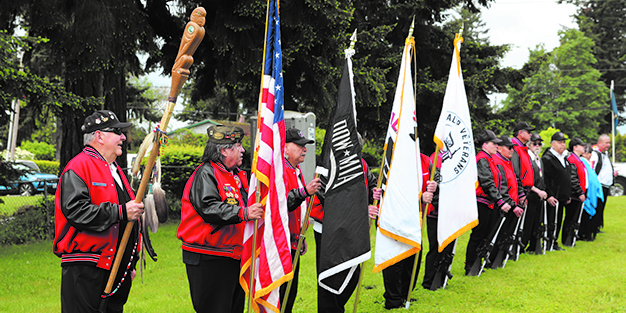
By Shaelyn Smead; photos by Kalvin Valdillez
Memorial Day is often a heavy day remembering the lost lives of fallen soldiers and veterans, but it also brings a sense of pride and honor to families and friends who once knew them. Much like years in the past, Tulalip community members gathered at the Priest Point Cemetery and the Mission Beach Cemetery to show respect for all the heroes that sacrificed and laid their lives on the line for our people and our country.
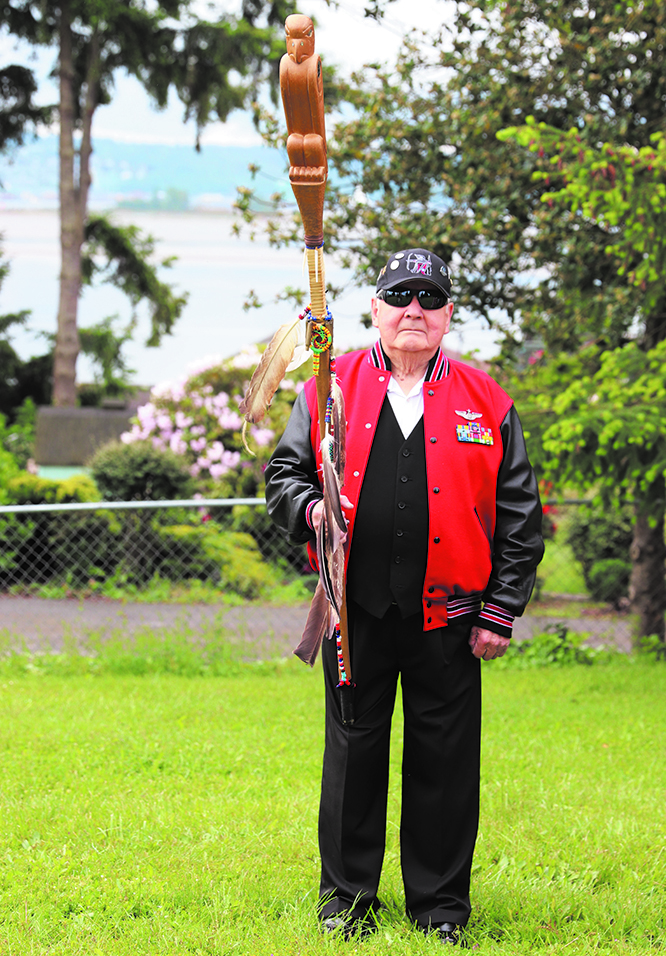
As family and friends arrived at the services, some stopped to surround the gravesite of their loved one; some placing down flowers and mementos representing their life, reflecting on the person that once stood side-by-side with them. American flags were put on display at gravesites to those that have served.
The services were held by the Tulalip Veterans Department, with Board of Director Mel Sheldon guiding those in attendance.
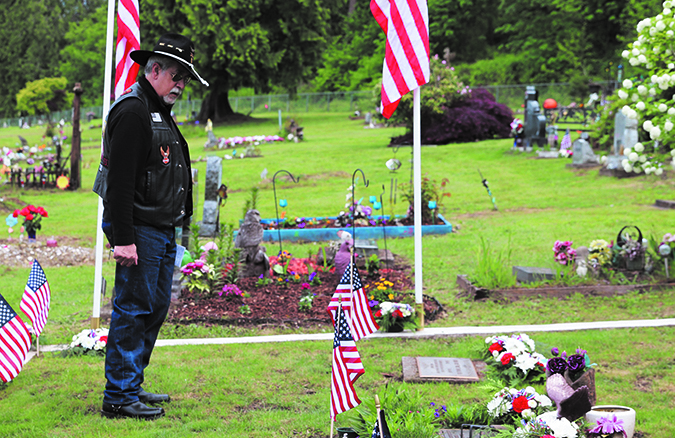
Mel reflected on the importance of recognizing Memorial Day saying, “When I think of this weekend, I think of all the men and women who served. Whether it be World War 1, World War 2, the Cold War, the Korean War, Vietnam, Iraq, or Afghanistan. We always come together to remember those who made the ultimate sacrifice. Tulalip has a rich history of men and women who have served this country, and we are proud of all our veterans. We remember so we don’t forget.”
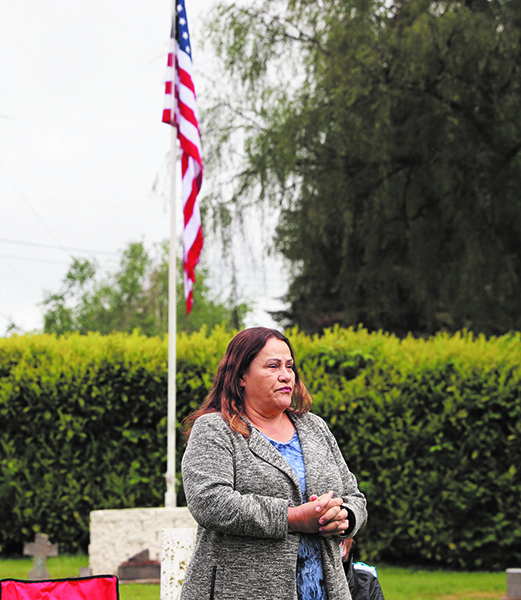
Chairwoman Teri Gobin paid special thanks to everyone in attendance, to the fallen soldiers, the veterans who have served, and to those who are still serving. She spoke about her father being a proud Marine, and the admiration for service members he instilled in her. She also paid a special thank you to the groundskeepers and cemetery maintenance crew that prepared the cemeteries for this month.
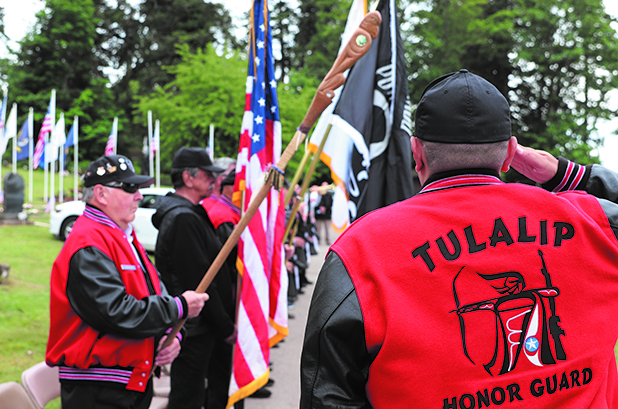
Tulalip Veteran Angela Davis spoke and shared her experience of being a veteran, and the bond that she shares with others, “With my uncles, father, and grandparents all being a part of the military, I knew from an early age that I wanted to serve. Being in the military, for some of us it’s a choice to join, but for others, it chooses them. There’s many different paths that you can choose from, whether it’s to be a politician, or a police officer, education, or preserving culture, we all have a servant’s heart. We want to give to our community and to our people.”
Many notable moments took place to pay tribute to the Gold Star mothers, fathers, families, and friends of fallen soldiers and veterans, acknowledging the sacrifice they too have made, and the pain that they have endured.
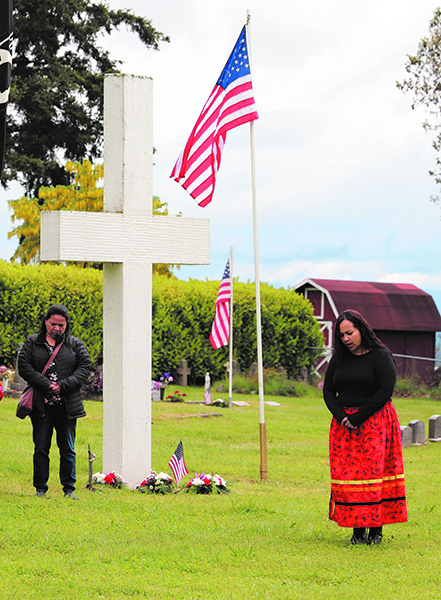
Native American culture has always encompassed a warrior identity. Tulalip veteran Cyrus “Cy” Hatch III exemplified this culture by holding roll call of the 247 fallen soldier and veteran names. A sense of honor and esteem swept over the tribal community members in attendance.
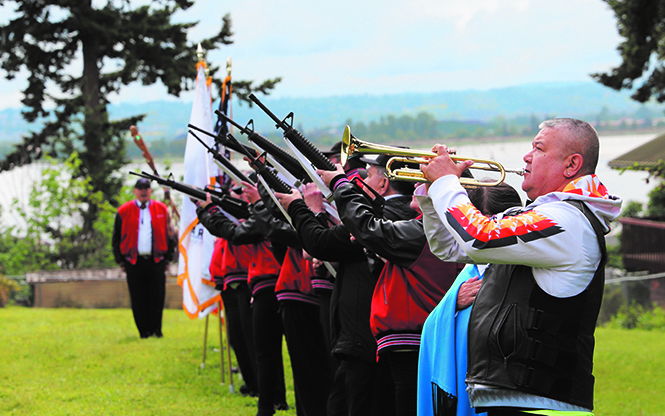
Ending the service was the Tulalip Honor Guard with a 21-gun salute, representing that Tulalip will always remember, so we don’t forget.
So, have you heard about World Day?
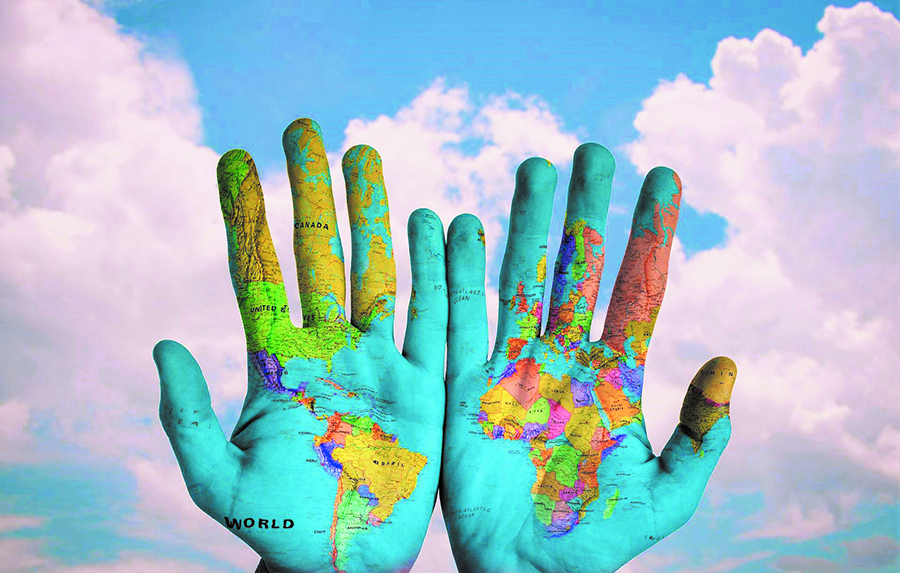
By Micheal Rios, Tulalip News
You’ve heard of World Day for Cultural Diversity for Dialogue and Development. Wait, you haven’t? No, it’s not Earth Day. It’s more like Earth Day’s illegitimate step-child.
Every year on May 21, World Day for Cultural Diversity for Dialogue and Development (we’ll just call it World Day) is celebrated around the globe. Every year since 2002, in case you’re wondering of its inception. Don’t worry if you’ve never heard about this glorious global holiday though, because you’re in the super majority.
There are plenty of reasons this particular day isn’t well known, most of which have to do with it being a legitimate attempt to accept and recognize cultural diversity.
“Celebrating cultural diversity means opening up new perspectives for sustainable development and promoting creative industries and cultural entrepreneurship as sources of millions of jobs worldwide – particularly for young people and especially for women. Culture is a sustainable development accelerator whose potential has been recognized in the 2030 Agenda for Sustainable Development adopted by the United Nations,” said Irina Bokova, former Director-General of the United Nations Educational, Scientific and Cultural Organization (UNESCO).
World Day was created by UNESCO in December 2002. Wondering what the heck UNESCO is? It’s a specialized agency of the United Nations. Its purpose is to contribute to peace and security by promoting international collaboration through educational, scientific, and cultural reforms in order to increase universal respect for justice, the rule of law, and human rights.
So, why the need for a World Day? Maybe because three-quarters of the world’s major conflicts have a cultural dimension. Because bridging the gap between cultures is urgent and necessary for peace, stability, and development throughout the world.
On the micro-level, as Native American people we are pretty experienced with cultural conflicts. Seems like every month, every week, and every day even, we are fighting some kind of cultural conflict; either externally with the U.S. government to enforce our Treaty Rights, internally between sister tribes squabbling of traditional fishing areas, or on some level in-between. Locally, there are never any shortages of cultural conflict stories to be heard when it comes to the city of Marysville and the Tulalip Tribes…and we’re neighbors. So it’s easy to see why bridging the gap between cultures is urgent and necessary for stability and development.
One way that culture gap can be bridged is by the implementation of Since Time Immemorial (STI) curriculum in the Marysville School District, amongst other school districts in the area. The ground-breaking initiative intends to teach the details of tribal sovereignty, Tulalip history, and contemporary tribal culture to students of all grade levels.
Imagine young children of all backgrounds and experiences growing up learning of, experiencing first-hand, and seeing through welcoming eyes the depth and beauty of Tulalip culture. The alleviation of so many misbegotten fears and nonsensical stereotyping would create spaces for a clear exchange of accurate ideas and stories that reflect the strong and vibrant Tulalip of today. The dream of a full implementation of STI curriculum in all Washington schools echoes the mission of World Day; to openly accept and acknowledge cultural diversity as a driving force of development with respect to personal growth and as a means of leading a more fulfilling intellectual, emotional and spiritual life.
We know that cultural diversity should be promoted not just some of the time, but all of the time. Cultural diversity is an asset that is indispensable for poverty reduction and the achievement of sustainable development. That is why World Day deserves to be known about and celebrated.
In recognition of World Day’s mission, the Snohomish County Human Rights Commission shared how the county is undergoing an explosion of diversity with profound social and cultural change. With an increasingly diverse population base, 15.6% of Snohomish County residents are foreign-born. They also noted that just a short 20-minute drive from Tulalip is the city of Lynnwood. What’s so interesting about Lynnwood is it has become a dense urban landscape in which nearly 50% of its residents are people of color. Making Lynnwood similar in demographics to the Tulalip Reservation, where nearly half are Tulalip citizens and the other half non-Natives.
All this is to say our local area, Snohomish County, is rapidly growing in diversity. However, we know that being diverse isn’t the same as recognizing and appreciating diversity. That’s why a day like World Day is important to acknowledge. The hope is that by talking about and honoring cultural diversity, as an inclusive and necessary framework for our very survival, we can bring about a more peaceful community and nation.
There are issues facing humankind – such as global warming, eradicating poverty and access to clean water – that will take all of us working together with a sense of unity and shared responsibility to solve.
While Earth Day is more like a club that you can join and say that you are part of, World Day for Cultural Diversity for Dialogue and Development forces you to take responsibility for your actions and actually walk your talk. This assertive stance is part of the reason it isn’t as popular with mainstream America. It calls for raised awareness about the importance of intercultural dialogue, diversity and inclusion. It calls for people to build a world of community rather than remain solitary individuals. It calls for commitments to support diversity with real and everyday action.
Now that you know about World Day, take a moment to think about its importance and what it means as a product of this world to help spread cultural diversity. Perhaps you’ll consider making a resolution to follow through with one of ten simple things you can do to celebrate this year’s World Day.
Ten simple things YOU can do to celebrate the World Day for Cultural Diversity for Dialogue and Development:
- Visit an art exhibit or a museum dedicated to other cultures.
- Invite a family or people in the neighborhood from another culture or religion to share a meal with you and exchange views on life.
- Rent a movie or read a book from another country or religion than your own.
- Invite people from a different culture to share in your customs.
- Read about great thinkers of other cultures than yours (e.g. Confucius, Socrates, Chief Seattle, Ibn Khaldun, Aristotle, Ganesh, Rumi).
- Next weekend visit a place of worship different than yours and participate in the celebration.
- Play the “stereotypes game.” Stick a post-it on your forehead with the name of a country. Ask people to tell you stereotypes associated with people from that country. You win if you find out where you are from.
- Learn about traditional celebrations from other cultures; learn more about Hanukkah or Ramadan or about amazing celebrations of New Year’s Eve in Spain or Qingming festival in China.
- Explore music of a different culture.
- Spread your own culture around the world through the UNESCO Facebook page and learn about other cultures.
May 28, 2022 syəcəb
Please use the following link to download the May 28, 2022 issue of the syəcəb
Following the Salmon Ceremony Part 6: Crafting Shawls & Vests
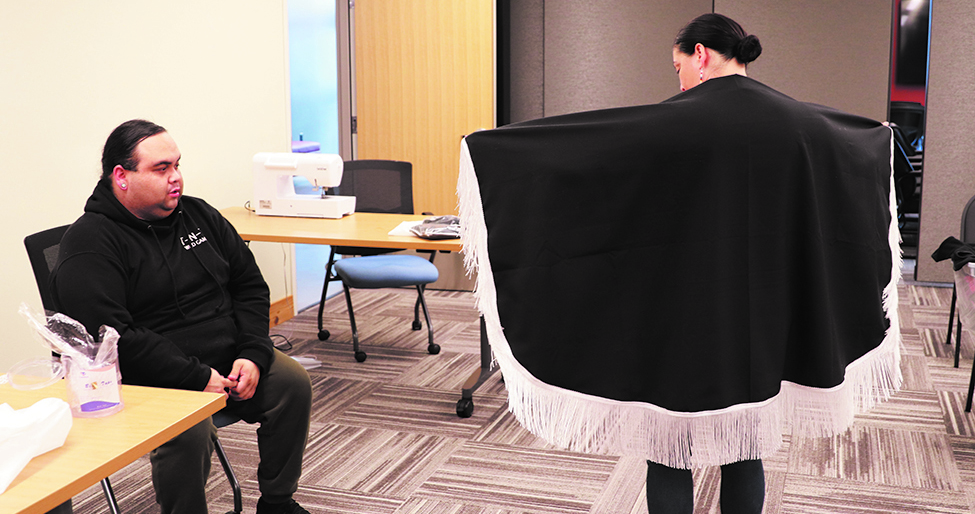
By Kalvin Valdillez, Tulalip News
Aside from the important spiritual work that is conducted at the Tulalip tribe’s annual Salmon Ceremony, one of the most captivating and spectacular aspects of the event is viewing all the regalia. Donning cedar hats and headbands, ribbon skirts and beautiful Indigenous accessories such as cedar-woven cuffs and beaded earrings, tribal members showcase their traditional gear at the ceremony, in which the local fishermen are blessed for a safe and plentiful season and yubəč, the first king salmon to arrive at local waters, is honored in a good way, as a means to pay respect to the entire species for providing nourishment for the people of Tulalip.
Much more than a fashion statement, the regalia serves an important role in the Salmon Ceremony. Shawls, which display family crests and colors, are visible as the dancers enter the longhouse. As the singers bellow songs and chants in traditional Lushootseed, the dancers depict the stories within the songs to onlookers.
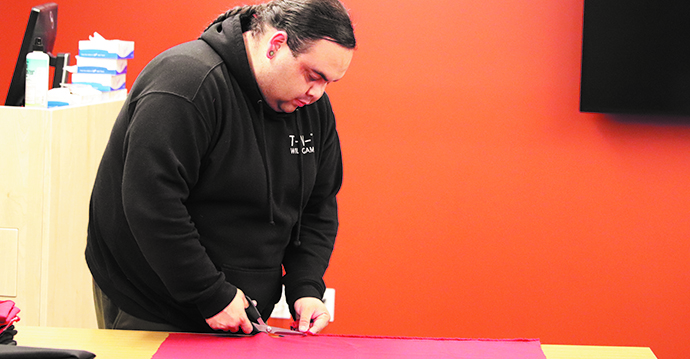
During a number of songs, including the Eagle/Owl Song (Tribute to Kai Kai), the Happy Song and the New Beginning Cleansing Song (Glen Gobin’s Song), the dancers utilize their shawls to perform the traditional work. Spreading their arms out wide as if soaring through the air, while turning in complete and semi-circles, the fringe of their shawls swooshes in the air to the drumbeats as the dancers work their way around the longhouse. During the ceremony, the boys and men wear vests. Similar to the shawls, the vests also showcase family emblems and often times, miniature cedar-carved paddles are arranged in multiple rows and dangle from the vests.
Creating your own regalia is an important experience for tribal members, whether it’s your first time participating at Salmon Ceremony or if you are returning to the tradition from a personal hiatus. Deciding the color and designs that your regalia will display helps create a strong connection to the official attire of the ancestors, and from that point on, a sense of pride is created each time you wear your regalia.
Traditionally, regalia was made exclusively from materials found locally in the natural world, namely cedar and the fur from the now extinct wooly dogs. A lot of time, attention and detail goes into crafting regalia and because of the effort put into making the shawls, headbands and vests, the regalia holds a special place in the hearts of each drummer, singer and dancer.

Although most tribal members craft their regalia within their families, there are numerous first timers this year, and like big chief yubəč, several returnees. Many of these Salmon Ceremony participants do not own any regalia whatsoever, and for this reason the Tulalip Tribes Events Manager, Malory Simpson, decided to host a weekly crafting circle.
Held every Tuesday at various locations throughout the reservation, but mainly at the Tulalip Gathering Hall, the crafting night allows Salmon Ceremony participants the opportunity to learn how to make their own shawls and vests. Malory explained that the budget, specifically for regalia, was quite a small amount, considering all the materials that needed to be purchased in order to make the regalia. She reached out to her community and recruited a small group of people to help raise funds to purchase fabric and all the tools needed to create shawls and vests for those in need of regalia.
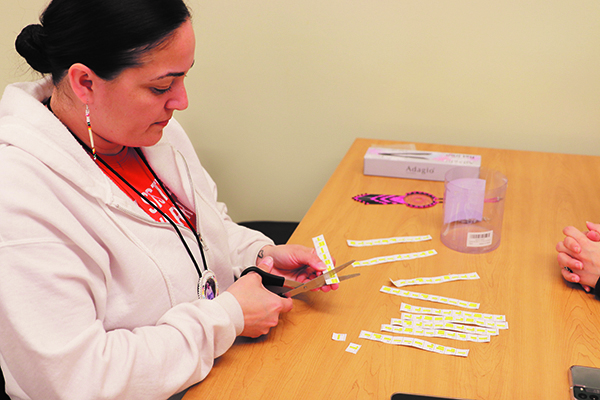
“We decided to do a fundraiser because it frees-up money to be spent more freely on other items we may need such as shells, smaller paddles, or maybe a vest or velour dress for different options of regalia,” Malory explained. “I was approached by a few different people about when we would be hosting a culture night or regalia making night. It was my understanding that the Events Manager never really coordinated that, but I felt the need to reach out to those who I knew were savvy in sewing and creating regalia. I have never done something like that before, so I knew I needed help. After a Salmon Ceremony practice, it was brought up by Glen Gobin that we needed to get a craft night going. Tuesday seemed to work for the majority, so we went with that day. We have ten shawls made as of now and I think twenty more to go.”
With only a few weeks before Salmon Ceremony, it is important for dancers and singers to have their regalia ready to go for the special day of honoring. Tribal leaders are inviting the entire community to come out to the remaining practices, held at 5 p.m. every Thursday at the Tulalip Gathering Hall, to learn about the revival of the ceremony and its importance to the tribe, as well as to immerse in the culture and learn the meaning behind the traditional songs and dances that are offered at the Salmon Ceremony. The last practice on June 9th will be held at the Tulalip Longhouse, where the Salmon Ceremony will also be hosted two days later on June 11th starting at 10:30 a.m.
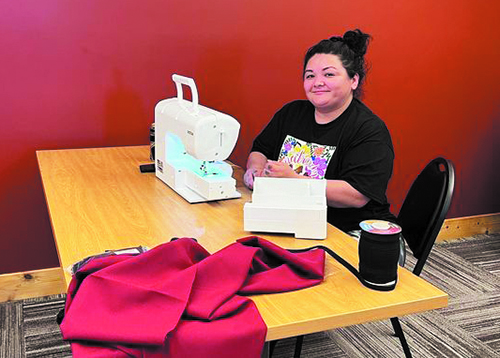
In a Facebook post following the first regalia crafting circle, tribal member Lena Hammons shared, “Awesome night of making shawls for Salmon Ceremony. I got two done and had to learn [how to operate] this sewing machine. Awesome dinner and great company! Much needed community time after two years of isolating.”
If you are interested in crafting regalia for this year’s Salmon Ceremony, please contact Malory at (360) 716-4399 for more information.
Celebrating Tulalip Wetlands
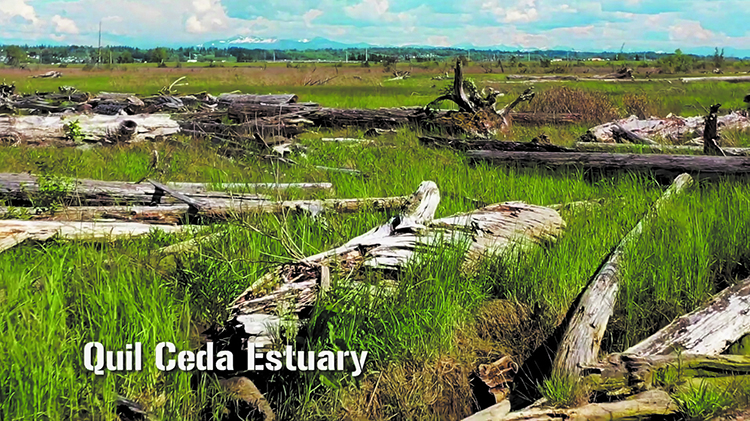
By Micheal Rios, Tulalip News
May is American Wetlands Month. A time to celebrate one of nature’s most productive ecosystems. Join us as we take this opportunity to give our readers a gentle reminder to take time to recognize the wonderful way wetlands enrich the local environment and our Tulalip way of life.
There are many types of wetlands, including coastal wetlands, potholes, vernal pools, bogs, and swamps, and each provide unique ecosystem benefits. Unfortunately, wetlands face numerous challenges, such as global warming and rising sea levels, as well as drainage, fill and excavation. These factors and more drive the critical need for wetland conservation and restoration.
In fact, wetlands are among the most valuable but least understood of all natural resources. They provide rich habitat for wildlife. They are place in which many animals and birds build nests and raise their young. Migrating birds stop over in wetlands to rest and to feed. We unknowingly celebrate wetlands each May when they are teeming with new animal and plant life.
Wetlands benefit our communities as well. They replenish and clean water supplies and reduce flood risks, provide recreational opportunities and aesthetic benefits. They serve as sites for scientific research and education, and provide massive benefits to our beloved Salmon runs.
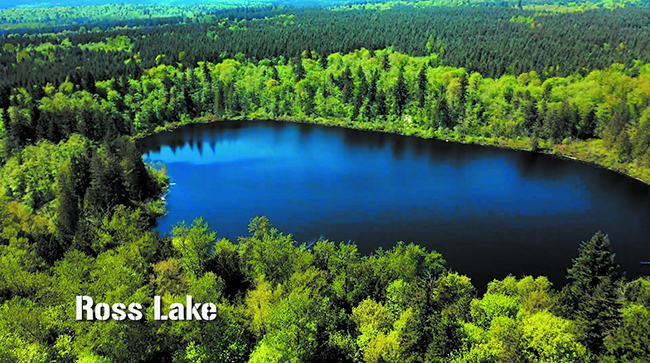
Unfortunately, wetlands have been misunderstood for many years, often viewed as wastelands to be drained and converted to other uses. But if wetlands disappear, water will not be as clean, fish and bird populations will suffer, and the frequency and severity of floods will increase. In recent years, there’s been a push by the scientific community and environmentalists to get mainstream America to recognize the value of wetlands.
Fortunately, for the Tulalip community, we have a dedicated Natural Resources team working diligently to protect and preserve our wetlands for future generations through various programs. One such member of that team is wetland biologist Michelle Bahnick. She recently spoke with Tulalip Media & Marketing’s resident documentarian, Justin Salva, at length about the importance of celebrating our Tulalip wetlands.
“We have over 500 wetlands on the Reservation, alone, and they make up approximately 20% of the Reservation,” explained Michelle. “We have wetlands connected to rivers, lakes, estuaries along the shorelines. We have depressional wetlands that just kind of may appear in your backyards. We have forested wetlands. We have wetlands that are predominately shrubs. We have ones that are basically grass fields that get wet.
“Wetlands are important for a bunch of different reasons. One easy one is that they recharge about 8% of the wells that are on the Reservation. Additionally, they provide habitat for anything from butterflies and birds to salmon and all sorts of insects. They also clean water by acting as sponges during storms and flood events. They help capture a bunch of water, hold onto it for a while, and then slowly releases the water back into the ground table or into streams and rivers. They also serve to help the water nice and cool during the summer for the salmon, as well as keeping river and stream flows consistent for salmon, too.
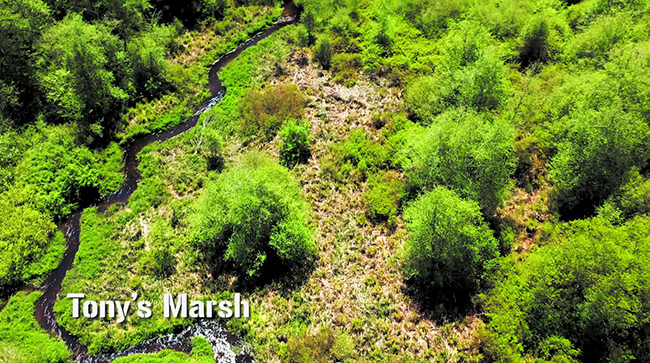
“Historically, in Washington State alone, over 50% of the wetlands have been diked or drained for the purpose of letting people use those areas for agriculture, for production and for developing housing. Luckily on the Reservation we’ve actually done a really good job, and since 1974 we’ve only lost about 2% of the wetlands. But we are still losing wetland area, and every time we lose wetland area we’re losing the flood protection, we’re losing water quality, and we’re losing habitat.
“Hopefully, in the future, we’ll have opportunities to create more wetlands or find ways to expand and enhance the existing wetlands that are here. Having a month dedicated to protecting wetlands is a good way to show that they’re beautiful areas and they are worth protecting.”
For more information on how you can help protect America’s wetlands, please visit https://www.epa.gov/wetlands Or if you’re interested in learning more about how our local Natural Resources team is working every day to sustain our traditions and culture, please visit their website: https://nr.tulaliptribes.com
Nearly 1,000 celebrate the return of tribal B-I-N-G-O
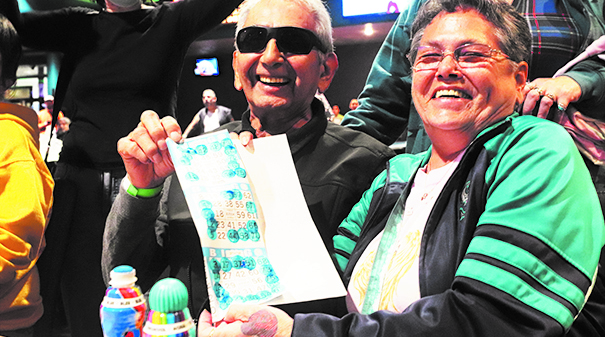
By Micheal Rios, Tulalip News
It’s been three years since local Tulalip citizens were joined by their fellow tribal members that journey from the polar north and deep south to fill Tulalip Bingo to max capacity for excitement-filled bingo sessions. The gift giveaway extravaganza went on an unprecedented hiatus due to COVID, but returned Monday, May 23 to the delight of nearly 1,000 Tulalip tribal members who valiantly attempted to daub their way into the winner’s circle.
“Who is ready to win some money?!” resounded Board of Director Mel Sheldon to kick-off the event’s return. Like he has done in years past, Mel reigned supreme on the mic as M.C. for the specialty 10:00a.m. and 5:00p.m. Tulalip-only sessions. He kept the atmosphere lively and upbeat with plenty of jokes and his witty banter.
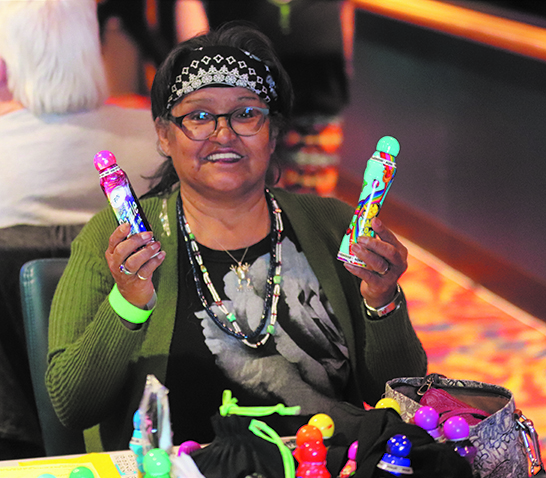
In total, nine-hundred and fifty-nine Tulalip citizens turned into dauber enthusiasts while enjoying the festivities and trying their luck to win high-end prizes or line their pockets with cold, hard cash during the 19th annual Tribal Bingo Celebration.
“We are honored to host our tribal bingo once again. We’ve brought fun and excitement to the membership for 19 wonderful years now,” said Tammy Taylor, Tulalip Bingo Director. “The beautiful part of our celebration is bringing the membership together for a fun time, free of politics and drama. Today really is all about our people enjoying each other’s company, sharing stories, and catching up with friends and family you don’t see often enough.”
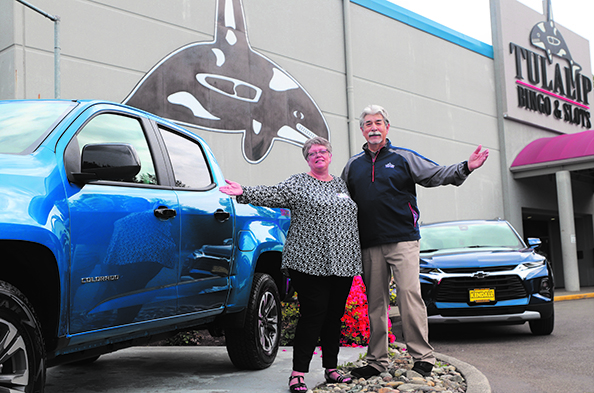
Bingo staff did their best to make the 19th annual celebration move along as smoothly as possible. They remained vigilant and attentive to the needs of bingo veterans and first timers who stayed glued in to their seats for close to three hours during each session. Every bingo player, whether using an electronic machine or traditional paper books, had an equal chance of winning cash and a number of door prizes, such as a 55” state of the art 4K OLED TV, an 8200 watt portable generator, and seven piece dining set.
Spanning each session were fifteen separate games of bingo, including hit favorites like Large Crazy Kite, Indian Star, and Blackout. During each session tens of thousands of dollars’ worth in total prizes were awarded to door-prize raffle and bingo winners.
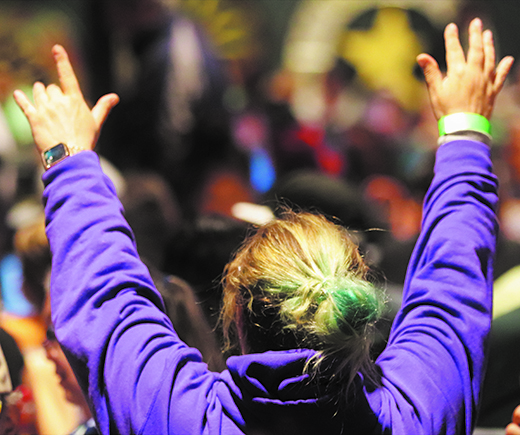
“Especially this year, given everything we’re still bouncing back from, it was a truly exciting time. So many came together to celebrate,” reflected Mel following the morning session. “Bingo has been a pastime for generations now. Seeing all the first time 18-year-olds who participated today, adding to our tribal family, really makes it worthwhile.”
“Bingo started us in the gaming industry way back in 1983,” added Tammy. “It’s been an amazing journey to where we are now. You could see so many big smiles, hugs being given, and loud laughs shared throughout today. From our Bingo team members to the Enrollment team members, everyone did a fantastic job start to finish.”
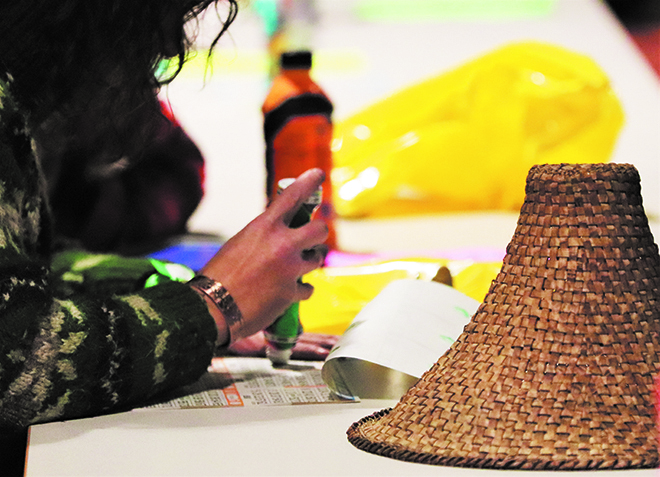
Smiles and laughs were had by many of the 959 tribal members who eagerly daubed away at their bingo cards during the multi-hour sessions. Some even made the most of a fifteen-minute break to try their luck at the slot machines, with one lucky tribal member cashing in on his bingo break with a $14,000 slots jackpot.
Adding even more stakes to this year’s tribal celebration was the addition of a grand prize vehicle giveaway concluding each session. The morning session brought all the intensity as five players called out “Bingo!” at the same time. To determine which person would ultimately win the 2022 Chevy Blazer sports utility vehicle, the five participated in a super stressful, single playoff game. With many tribal members sticking around to see who would win, cheers galore rang out as elder Lenny James came out victorious

The 79-year-old was grinning ear to ear with his patent shades on while checking out his new ride. “I was so nervous during the playoff session that I couldn’t even daub the paper. My wife had to do it for me,” shared Lenny. “My current truck is quite the gas guzzler, getting something like 11-miles per gallon, so having something just as roomy but with much better fuel efficiency sounds real good right about now.”
During the evening session, the grand prize winner of a 2022 Chevy Colorado truck went to 20-year-old Paulette Williams. She admitted this occasion was her first time ever playing bingo and throughout the session she almost bailed early multiple times. Luckily, she stuck around.
“I thought I was going to go home a loser for sure. Guess not, huh,” joked Paulette with her friends as she started up her truck for the first time. “I’ve never had my own truck before. This is pretty cool. I like it. Three different times I was ready to leave and do something else because I wasn’t coming close to winning any of the bingo games. Now, I’m really looking forward to cruising to the beach and doing some donuts.”
Who knew yelling out “BINGO!” would result in doing donuts on the beach? Yet, another super cool memory made at the annual tribal bingo celebration. Next, years can’t come soon enough.
May 21, 2022 syəcəb
Please use the following link to download the May 21, 2022 issue of the syəcəb
Following the Salmon Ceremony Part 5: The Songs of the Ceremony
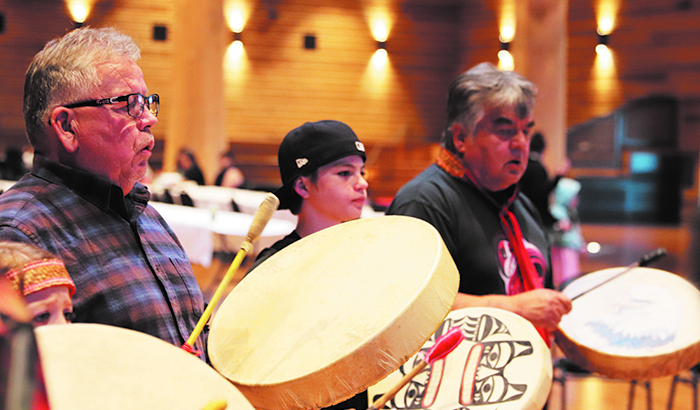
By Kalvin Valdillez, Tulalip News
“The elders taught us that we always need to be listening because some day you’ll be tapped on the shoulder to say something, to take over or lead something, and you need to be prepared,” said Tulalip tribal member, Glen Gobin. “Back in 1968, before the revival, they wanted the youth, which at the time included myself and my siblings, to start to learn some of the songs that we still use as part of the Salmon Ceremony today – the welcome song, the happy song. We were taught those songs at early age and I always felt honored to be a part of that.”
With less than a month to go, the tribal community of Tulalip continues to prepare for their annual Salmon Ceremony gathering, which will be held this year on Saturday June 11, beginning at 10:30 a.m. at the Tulalip Longhouse. Over the past four weeks, dancers, drummers and speakers have been getting reacquainted with their traditional songs by participating in weekly practice sessions, starting at 5:00 p.m., every Thursday.
The practices have been hosted at the Tulalip Gathering Hall, however, the final practice on June 9th will be held at the longhouse. During the approximate two-hour practice session, the tribe takes time to walkthrough the entire Salmon Ceremony from top to bottom, so the people can really get an understanding about what the songs and dances mean to the tribe, and why they are offered each year.
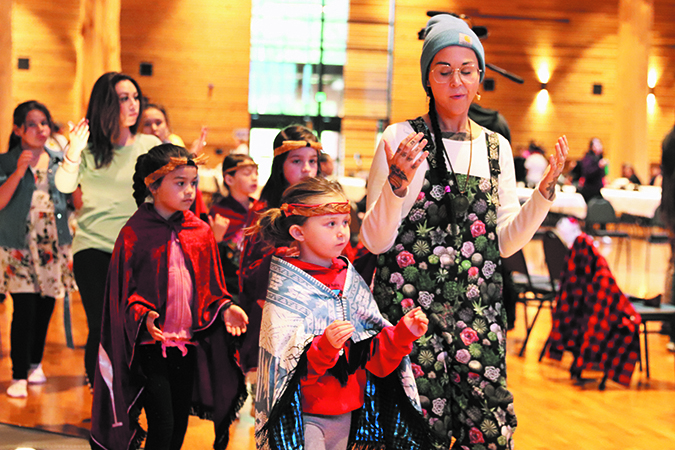
“I love being at the center of the longhouse when we’re all in there together and we all sing [The Prayer Song] for the first time,” Glen expressed. “The power of song with all our voices is very moving, you can feel it inside you. I try to get the kids to feel that – the power of our voices. It gives you strength and encouragement and it also makes you feel that you belong, that you fit in.”
Revived back in the mid-70’s, the Salmon Ceremony has become a staple tradition at the start of each fishing season for the people of Tulalip. During the ceremony, the tribe welcomes and honors the first king salmon to arrive at local waters. The ceremony also serves as a way to provide the fishermen of the tribe with a blessing before they hit the Salish Sea to harvest salmon for their people.
Prior to the assimilation era, the Salmon Ceremony was practiced by the Snohomish people since time immemorial. The ceremony was brought back in an historic effort by Harriette Shelton Dover and a handful of elders who were able to recall the songs and dances that were performed at the event. Those songs and dances were then passed on to the next generation. And ever since, the tribe has passed down the teachings year by year to the future of Tulalip.
Many Salmon Ceremony participants will be the first to tell that the practices leading up to the actual ceremony are equally important as the special day of honoring itself. Tribal leaders are welcoming the entire community out to the remaining practices, four in-total before the big day.
In 2020, for the first time since the revival, the Salmon Ceremony and all the practices were canceled due to the pandemic. In 2021, the tribe brought the ceremony back, but in an effort to limit the spread of COVID, there were no practices leading to the event. These important practices, where traditions are handed down to the next generations, were canceled for two straight years in a row, and the participants felt as if a significant piece to the ceremony was left out. Now with the return of the practices, the people feel a stronger connection to the songs, dances and stories that will be shared at the ceremony.
Said Glen, “It’s about giving respect to those that come from nature. But it also teaches about giving respect throughout life and honoring those gifts that we get and respecting our way of life in a good way. Part of that is making sure how we sing the songs, how we conduct ourselves, it teaches how to carry yourself in life. All of the songs have meaning, everything is connected. The songs encourage the people to carry themselves in a good way.”
In anticipation of the Salmon Ceremony, Tulalip News has been featuring a weekly mini-series focused on the all the important work that goes into the annual event. Over the past four weeks, we took a deeper look into the ceremony, highlighting its history and stories. This week, we sat down with Glen, the official Salmon Ceremony Leader, a title handed down from the late Stan ‘Scho-Hallem’ Jones and Bernie ‘Kai Kai’ Gobin, to go over the eleven songs, blessing and chants that are offered at the ceremony each and every year.
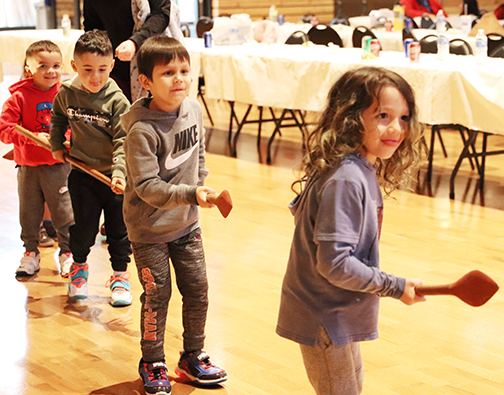
The Welcome Song
Glen: “The Welcome Song is well-known and it is Harriette Shelton Dover’s song. For a long time, when we sang her song, Harriette was the only one in front of everyone, with the strongest drummers and singers following behind her. Now we have four elders leading us, typically two times around the longhouse, to start the ceremony.”
Sduhubš War Song
“This is where all our young warriors line up with their spears. A while ago, I was back at D.C. at the National Archives building. In some of the writings there is a record of this song, the sduhubš war song. And it tells what the meaning is: I am Sduhubš, I am a fierce warrior. I have nothing but friends, for I have already killed all our enemies.”
Eagle/Owl Song (Tribute to Kai Kai)
“You know, Stan always called it the Eagle/Owl song, but nowhere in the song do we sing about the eagle. But anyway, it’s a Jones family song and he gave it to the ceremony. Scho-Hallem gathered Kai Kai, because they grew strength from each other and prayed for each other. Kai Kai was my father, him and Scho-Hallem were very close friends. They were very strong leaders for our tribe. They worked together as a team for our tribe to help us move forward to where we are today.”
Blessing Song
“The blessing of the fishermen! This was a song that was gifted to Stan and my dad by a lady named Bev Tom. It is about remembering your ancestors and remembering where you come from. It’s a blessing of the fishermen to wish them good luck and a safe season.”
Listen to our Prayers
“I love being at the center of the longhouse when we’re all in there together and we all sing this for the first time. The power of song with all our voices is very moving, you can feel it inside you.”
hikw siyab yubəč
“This song is one of the primary Salmon Ceremony songs. These are all prayer songs. We sing this all the way down to the beach, once yubəč is here. We sing this to greet our visitor. Once the canoe has landed, and he’s unloaded, he now leads the way. From this point for the rest of the ceremony, he’s at the front, nobody goes in front of him. We sing this all the way to the longhouse and then again when we take him back to the water. We recognize him, give thanks. He is the scout, he comes to see how well we are doing and if we treat him correctly, he’ll tell his people that the Tulalip’s are good people.”
Happy Song
“This is a crowd favorite where the Shawl Dance is performed. Back in 1968, before the revival, they wanted the youth, which at the time included myself and my siblings, to start to learn some of the songs that we still use as part of the Salmon Ceremony today – the welcome song, the happy song.
We were taught those songs at early age and I always felt honored to be a part of that. All of the songs have meaning, everything is connected. The songs encourage the people to carry themselves in a good way. And that goes back to the sduhubš people, we were always considered high class. But not high class like I’m better than you. Others viewed our people as siyab, high class people, because the way we carried our people.”
Table Blessing Song
“The table blessing song is thousands of years old, it’s been around that long and that’s how it was shared with us. It’s a very powerful song. It’s not often that you have a prayer song that has that fast of a beat, that you sing it that loud. Maybe it’s a joyous prayer. We all take a small piece of fish and eat the guest at the same time. Then we all take a drink of a half-glass of water together at the same time.”
Canoe Song (Kenny Moses Jr.’s Song) & New Beginnings Cleansing Song (Glen’s Song)
“Through the years we added some songs at the end. It used to end to stop at hikw siyab yubəč, but then the canoes still had to paddle out. That’s when Kenny’s song came. We started singing Kenny’s song for the canoe returning to the shore once more.
But then the girls wanted another song that they could dance to, because they didn’t want to leave, so I shared my song at the end. It’s a song of cleansing and new beginnings. It’s about, as you walk through life, you gather up all these things and you hang on to them. At different times you need to start to release them, because either some of those things start to bother you or you no longer need them so you release those things and only keeps what gives you strength and keeps you going. So you’re starting over again, that new beginning and you’re cleansing by releasing what doesn’t serve you.
When that song came to me, it was weird because I never thought I would receive a song. We were doing some spiritual work, canoes were put away for a year, we brought them back out and brushed them off and put them in the water. We were coming back by the longhouse and I was coming up the hill and the song started coming to me like a ton of bricks. I got home and sang it for about two hours. I drove around all week, singing it all the time. It wouldn’t leave. So finally I called Kenny Moses Jr. He came up to my dad’s house and I sang it there. He asked me about what I was thinking of and feeling at the time. It’s kind of a cleansing song about new beginnings.”